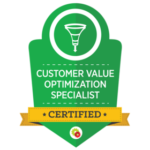Archives for January 2017
Common eCommerce Mistakes | Decades of experience – Part #1
E-Commerce is most likely a major profit center for your business. However, you’ve seen more and more competitors enter the arena in an attempt to remove your edge. To maintain that advantage you need a planned approach followed by relentless execution.
We see quite a few mistakes as we analyze the e-commerce platforms of prospective clients. Most of the mistakes are the same every time. In this series we will layout what those mistakes are, how to analyze their impact and how to overcome those you may have.
The fact of the matter is, that you have made an enormous investment in ecommerce. From a consultive standpoint, we do not see a day on the horizon that will end that investment fuel. We recognize that balancing your available capital, your business goals and your multichannel marketing strategy can be difficult to say the least. We also know that the benefits are immense, assuming your proverbial ship comes in.
The leadership team at Viral Solutions has spent decades coaching small business owners, managing direct report sales people, consulting businesses with both a brick-and-mortar and ecommerce presence and providing marketing and sales process oversight to some of the top businesses in the country.
We have witnessed some common mistakes, some we see repeatedly, and come to a conclusion of why they exist. Our hope is to arm you with strategy, tactics and information so that you can compare and contrast a standard of best practices to your approach. Admittedly, some of these mistakes we have made ourselves. Success is a horrible teacher.

Strategic Planning Trumps Tactics and Widgets
Many businesses that we support have an idea of what they are doing with their digital marketing. However, the majority do not have a written strategy. Most started with a passion for a craft, trade or cause and fell into digital marketing as the technology became available. Giving little thought that this venture was any different than the yellow pages or a sign post.
Today the online stars of e-commerce have a road map, have carefully designed campaigns and present their customer with an excellent experience. This designed customer journey is backed by data so that the business owner can stay ahead of the ever shifting landscape. They have a strategic marketing plan that identifies their buyer persona, they understand the prospective customer’s need, they view actions as being predictable, they coordinate advertising with their content publications and they have built a business model that can execute the delivery to fulfill the need they target.
Perhaps you are not making any mistakes and if that is the case we salute you. However, if you are like we once were, perhaps you identify with some of these mistakes. We believe that by following a set of beliefs and facts, you too can improve your ecommerce return-on-investment.
Mistakes Witnessed
In a series of articles over the next several months we will drill-down into the most common areas where businesses make mistakes with e-commerce.
We recognize that the technology needed to establish an ecommerce platform has eliminated many obstacles for business owners. The tools, widgets and gadgets are relatively easy to setup so that you can sell on Amazon, Etsy or your own site.
However, this is where the problems begin. This isn’t the Field of Dreams set. This is business on a very competitive landscape.
Maintaining your own online shop is no small task. Long hours and polarizing opinions are your daily grind. What is successful today can be a disappointment next month without notice.
We have witnessed great ideas, innovative offers, services that fit a defined need and revolutionary products on e-commerce platforms. Only to find those systems, processes and business owners being unable to execute a plan to finality.
Why? What do these businesses have in common? What are the most common ecommerce mistakes? How can you avoid the same mistakes?
Realizing problems will arise in the future is part of the battle. Most of those problems are predictable and there is little need to reinvent the wheel when you search for solutions.
Join us as we help you avoid the most common mistakes ecommerce businesses make.
Copyright 2017 Viral Solutions LLC
We help overwhelmed small business owners duplicate themselves – so business can be fun again.
Viral Solutions LLC is a Digital Marketer Certified Partner, an Infusionsoft Certified Consultant and a Google Partner – Certified in AdWords.
Common eCommerce Mistakes | Decades of experience – Part #1
E-Commerce is most likely a major profit center for your business. However, you’ve seen more and more competitors enter the arena in an attempt to remove your edge. To maintain that advantage you need a planned approach followed by relentless execution.
We see quite a few mistakes as we analyze the e-commerce platforms of prospective clients. Most of the mistakes are the same every time. In this series we will layout what those mistakes are, how to analyze their impact and how to overcome those you may have.
The fact of the matter is, that you have made an enormous investment in ecommerce. From a consultive standpoint, we do not see a day on the horizon that will end that investment fuel. We recognize that balancing your available capital, your business goals and your multichannel marketing strategy can be difficult to say the least. We also know that the benefits are immense, assuming your proverbial ship comes in.
The leadership team at Viral Solutions has spent decades coaching small business owners, managing direct report sales people, consulting businesses with both a brick-and-mortar and ecommerce presence and providing marketing and sales process oversight to some of the top businesses in the country.
We have witnessed some common mistakes, some we see repeatedly, and come to a conclusion of why they exist. Our hope is to arm you with strategy, tactics and information so that you can compare and contrast a standard of best practices to your approach. Admittedly, some of these mistakes we have made ourselves. Success is a horrible teacher.

Strategic Planning Trumps Tactics and Widgets
Many businesses that we support have an idea of what they are doing with their digital marketing. However, the majority do not have a written strategy. Most started with a passion for a craft, trade or cause and fell into digital marketing as the technology became available. Giving little thought that this venture was any different than the yellow pages or a sign post.
Today the online stars of e-commerce have a road map, have carefully designed campaigns and present their customer with an excellent experience. This designed customer journey is backed by data so that the business owner can stay ahead of the ever shifting landscape. They have a strategic marketing plan that identifies their buyer persona, they understand the prospective customer’s need, they view actions as being predictable, they coordinate advertising with their content publications and they have built a business model that can execute the delivery to fulfill the need they target.
Perhaps you are not making any mistakes and if that is the case we salute you. However, if you are like we once were, perhaps you identify with some of these mistakes. We believe that by following a set of beliefs and facts, you too can improve your ecommerce return-on-investment.
Mistakes Witnessed
In a series of articles over the next several months we will drill-down into the most common areas where businesses make mistakes with e-commerce.
We recognize that the technology needed to establish an ecommerce platform has eliminated many obstacles for business owners. The tools, widgets and gadgets are relatively easy to setup so that you can sell on Amazon, Etsy or your own site.
However, this is where the problems begin. This isn’t the Field of Dreams set. This is business on a very competitive landscape.
Maintaining your own online shop is no small task. Long hours and polarizing opinions are your daily grind. What is successful today can be a disappointment next month without notice.
We have witnessed great ideas, innovative offers, services that fit a defined need and revolutionary products on e-commerce platforms. Only to find those systems, processes and business owners being unable to execute a plan to finality.
Why? What do these businesses have in common? What are the most common ecommerce mistakes? How can you avoid the same mistakes?
Realizing problems will arise in the future is part of the battle. Most of those problems are predictable and there is little need to reinvent the wheel when you search for solutions.
Join us as we help you avoid the most common mistakes ecommerce businesses make.
Copyright 2017 Viral Solutions LLC
We help overwhelmed small business owners duplicate themselves – so business can be fun again.
Viral Solutions LLC is a Digital Marketer Certified Partner, an Infusionsoft Certified Consultant and a Google Partner – Certified in AdWords.
Building Authority Through Great Content
One of the biggest trends in the world of digital marketing today is “content authority,” the idea of building yourself as a trusted source in your company’s particular field. Over the course of the next several weeks, we are going to discuss in detail the major components of authority content, which include quality, trust, branding ability and influence. Today, however, let’s get a general sense of what exactly authority content is and why it’s important for businesses to develop a strategy that positions themselves as a respected authority.
Content authority: a general overview
By now, most brands that have an online presence understand they must engage in content marketing to be able to maximize their visibility and their ability to generate new leads and conversions. However, a large portion of these brands still do not understand how to plan out a content strategy that will make their marketing campaign successful.

The methodology of content authority helps you better understand how to increase the effectiveness of your content throughout your marketing campaign, rather than just helping you figure out what to write. If you fully understand content authority, you will be able to improve your search engine visibility, your social media engagement and your linking on external sites relevant to your company.
Of course, the additional visibility and engagement you get online through authority content is only one of the reasons why you should strive to be an online authority in your field. Here are a few more of the primary advantages of becoming an online authority:
● You will gain significantly more trust from prospects and customers, which in turn is likely to lead to more sales.
● You will gain the respect of your peers in your industry, which could open up avenues for some beneficial and lucrative business opportunities and partnerships.
● You will be able to get traction on various new ventures and projects significantly faster, which will help you cut down on how much you’re spending on your marketing campaigns.
● You will get significantly more traffic and links to your website or blog from people who view you as a go-to source in your industry.
● You will get many more referrals, both online and offline, from people who have seen your content and know you to be a trustworthy company.
Individual authority as important as brand authority
As you begin creating content on your website and blog, one of the first decisions you will need to make is whether this content will be under the name of the brand, or of the individual person who developed the content.
These days, the trend seems to be to have individuals posting content under their names on company websites. This makes sense, when you think about it. People want to be able to connect with other people, not anonymous brands, and content marketing is all about forging strong connections. If people have a name or face to associate a piece of content with, they will be able to connect to that content more deeply, and therefore be more easily influenced by what they are reading.
As each individual author publishes more content, there are several benefits here that cannot be understated. The company benefits in that this content is being published to its site, showing that the business has a number of intelligent thought leaders in its field working for it. The individual benefits in that they will have content tied to their name, helping them build themselves up as thought leaders and influencers in their field. It’s essentially a win/win arrangement for brands and individuals alike.
Measuring content authority success
As with any other marketing tactic, you need to be able to measure the success of your authority content to truly be able to build authority.
A big metric to pay attention to is customer journey. Where are users entering your website? After they read one blog post, are they likely to read another one or make a purchase, or do they leave the site right away?
Time spent on each page is also a big metric to watch. Higher time per page indicates users are taking the time needed to carefully read your content and take in all of the information it contains. A low time per page or high bounce rate indicates the content might need work.
Other metrics to pay attention to include sentiment, ranking, views, conversions, clicks, impressions, completions, shares and more.
Now that you have a general knowledge of what content authority is, we will move on next week to discussing the first element of creating content authority: developing high-quality content.

Queen of the Machine for Viral Solutions LLC

“If a brand genuinely wants to make a social contribution, it should start with who they are, not what they do. For only when a brand has defined itself and its core values can it identify causes or social responsibility initiatives that are in alignment with its authentic brand story.” ~ Simon Mainwaring
CRO Series: Analytics to Help Track Your CRO Success
We have reached the fifth and final part of our conversion rate optimization (CRO) series. So far we have discussed in detail what exactly CRO is, why it is important, how to create target buyer personas and how to reach out to those personas, including the use of conversion funnels. Today we bring home the discussion with a look at some of the most important analytics you can use to track the success of your company’s CRO.
Google Analytics is perhaps the easiest and most effective tool to use to track these analytics. It provides you with most of the key information you need to truly measure the success of your CRO. Here are some of those metrics you should be analyzing to determine what sort of adjustments you need to make to get the most out of your digital marketing:

- Bounce rate: The bounce rate of your site tells you how long people are staying on the site before they navigate elsewhere. You can get bounce rate for specific pages, or for your overall domain. You can even categorize pages, and get specific bounce rates for product page categories versus your home page or about page. Bounce rate has a very strong correlation with the next metric on our list.
- Time on site: Time on site is the average length of time your users spend on each session on your website. Combined with other metrics, such as bounce rate, time on site can give you some important information about the performance of your site. For example, depending on what other metrics tell you, a large amount of time on your site could either indicate people find your content really interesting, or that there are navigational issues that make it difficult for people to find their way to the correct section of the site. What’s really beneficial about the time on site metric is that you can split it into different categories. For example, you could look at the average amount of time spent on the site by a person who came in through organic search, rather than paid search.
- Pages per visit: Again, this metric goes hand-in-hand with bounce rate and time on site. A high bounce rate would probably indicate a low pages per session. More pages per session means customers are taking the time to look through your site, which means they are clearly interested and therefore more likely to result in a conversion.
- Devices: Ever wonder about how the habits of your users vary across their different devices? These analytics provide you with that information. You can look at key analytic information such as session time, bounce rate, pages per session and new users across platforms such as desktop, mobile and tablet. If your analytics vary drastically across these platforms, you will probably need to make some adjustments to ensure that people across all devices are getting a good browsing experience.
- Exit percentage: Exit rate refers to the people who visit multiple pages then left the page on the last site visited. Therefore, the exit percentage for each page is the amount of people who left the site after visiting that page. Bounce rate only refers to people coming to a single landing page and leaving immediately, while exit percentage refers to people visiting multiple parts of the site. A high exit percentage could mean a couple things: either that you need to better optimize your area of the site, or, if it’s a sales page, that you succeeded in creating a conversion.
- Site speed: The slower the site speed, the fewer conversions you are likely to have. Site speed can be affected by a number of different factors, including overuse of media, heavy server strain, poor functionality and more. Any page taking more than a few seconds to load should be better optimized to enhance the user experience.
- Path length: You have the ability to track the journey your users take from entering your site to making a sale. Ideally this path would be as short as possible, though any conversion is good.
- Acquisition: Acquisition information allows you to analyze how people are coming into your site, and which sources of traffic are most likely to lead to conversions. So, for example, you could compare users coming from organic search, direct links, paid search, social media, email, referrals and other sources and see how their behaviors differ.
- Shopping Cart Abandonment: Shoppers usually leave merchandise in their shopping cart when they experience an unexpected costs, have second thoughts or they found a better offer elsewhere. By tracking your checkout funnel, we can find out at what stage your shoppers are abandoning you and see if it corresponds with one of the above reasons. Google Analytics uses Intelligence Events. Knowing how many orders were placed versus the number of shopping carts created. To do so you will inform GA what page is your cart and what page is the checkout.
These are just a few of the many metrics available for your use in Google Analytics, which will help you get a better idea of your conversion rate optimization performance. By tracking these metrics and using the information available to you, you can change various elements of your website to create a better user experience.
We hope you have enjoyed this series on conversion rate optimization. For more information about CRO and how you can apply these principles to your company, we encourage you to reach out to our team at Viral Solutions.

Thomas von Ahn
Chief Elephant Slayer for Viral Solutions LLC

“Achievement seems to be connected with action. Successful
men and women keep moving. They make mistakes but they
don’t quit.” — Conrad Hilton
Let's Chat! Set up an appointment with me HERE.


